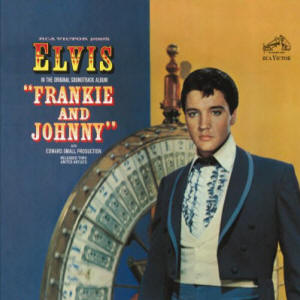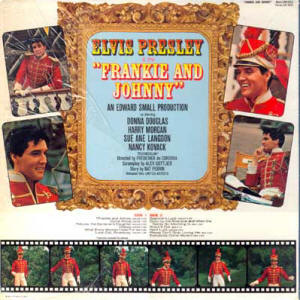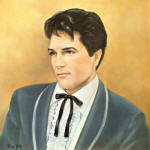

On March 1, 1966 RCA Victor released "Frankie
And Johnny", the soundtrack album of Elvis'
latest motion picture. Starting on April 23rd
Billboard listed the record on their "Top LPs
Chart". The 250,000 units were enough to make it
stay for 19 weeks and peaking at number 20. In
Great Britain the king was more successful and
made it to number 11. In total "Frankie And
Johnny" sold 2 million copies, which translates
to 300 million paid streams of the complete
album or 3 billion paid streams of individual
tracks. Unfortunately these figures confirmed
the negative trend, because apart from the
compilation "For LP Fans Only" (1959) no Presley
album to date had sold worse than this one.
In 2016 the complete Presley catalogue was
restored and remastered by Vic Anesini for a
boxed set of 60 compact discs called "The Album
Collection". Sony Music Entertainment provides
the streaming platforms with the same versions
of the individual albums (some of them offering
bonus tracks), albeit in 24 bit/90 khz flac.
That means, if the platform of your choice
supports high resolution audio, you can enjoy
the tracks in the same quality Sony used to scan
and master them. On Spotify, which has a market
share of approximately 30% and is the only
platform that publishes streaming figures,
"Frankie And Johnny" accumulates 3 million
streams and is requested 1,000 times per day. So
today the album is as unpopular as it was in the
1960s. It doesn't help too much, that "Harum
Scarum" by now has underperformed "Frankie And
Johnny".
Because Elvis had put on a few pounds and his
manager regarded his face a bit too puffy, the
art department of RCA Victor photoshopped (there
was no Photoshop in 1966, but everybody knows
what I'm talking about) an older head (a promo
picture for the movie "Girl Happy" was used) on
the singer's recent body. The work was done in a
sloppy way, so the "new" head was a tad too
small and therefore looked somewhat strange. On
the back cover, where much smaller pictures were
used, the label presented photos from "Frankie
And Johnny".
Once again RCA Victor tried to push the sales
by adding a bonus photo to the first edition of
the album. This time it was a reproduction of an
oil painting of Elvis, made by June Kelly.

In 1976 the Pickwick label released a budget
version of "Frankie And Johnny". To read a
review of the release tap
HERE. Sony Music
Entertainment's own collector's label Follow
That Dream Records released a classic album
edition in 2003. Besides the tracks of the
original release it also included several
outtakes. For the review tap
HERE.
The album has a running time of 26:40
minutes.
The album was recorded between May 12th and
14th, 1965 at Radio Recorders in
Hollywood/California. On May 19th Elvis
overdubbed his vocals to "Hard Luck" at the
Samuel Goldwyn Studios, where the movie was
made. The sessions were produced by Fred Karger,
the sound engineers were Dave Wichman (Radio
Recorders) and Kevin Cleary (Samuel Goldwyn
Studios). Elvis' band consisted of Scotty Moore
(guitar), D. J. Fontana (drums), Hilmer J.
Timbrell (guitar), Charlie McCoy (guitar and
harmonica), Bob Moore (bass), Murrey Harman
(drums) and Larry Muhoberac (piano). The
southern flair was added by George Werth
(trumpet), Richard Noel (trombone), Gus Bivona
(clarinet and saxophone), John Johnson (tuba)
and Robert Cowin (tuba). For the harmony voices
The Jordanaires (Gordon Stoker, Hoyt Hawkins,
Neal Matthews and Ray Walker) as well as Millie
Kirkham were booked. On "Look Out, Broadway"
Eileen Wilson sang the part of Donna Douglas and
Ray Walker sang the part of Harry Morgan. The
song "Chesay" also featured the voice of Henry
Cordin. On the movie version of "Frankie And
Johnny" Sue Ann Langdon, Donna Douglas, Sherry
Thober, Lyzanne Ladue Goodon, Elizabeth Harrower
and Doris Bourgeous sang along.
Frankie And JohnnyThe
traditional from the 19th century was also known
as "Frankie And Albert". It exists in many
different versions, but they all have in common
that Frankie kills her lover Johnny (or Albert)
because of jealousy. In some versions she lands
in jail, in others she gets executed. Alex
Gottlieb, Fred Karger and Ben Weisman adapted
the traditional for Elvis, who recorded it on
May 14, 1965 within six takes. "Frankie And
Johnny" is one of my favorite movie tunes,
because it differs from the usual ones and is
performed very well. In 1966 RCA Victor also
released the song on a single, six years later
CAMDEN used the track on the album "Elvis Sings
Hits From His Movies - Volume 1".
Come Along
Dave Hess based the song on the traditional
"Gonna Raise A Ruckus Tonight". The first
recording was made in 1923 by the Norfolk Jazz &
Jubilee Quartet. On May 12, 1965 the ryhthm
track was recorded, on the next day Elvis added
his voice. The master was a combination of take
6 (music track) and take 1 (vocal track). The
song generates a nice southern states feeling
and the melody stays with you.
Petunia, The Gardener's Daughter
In the movie the song is performed at a
riverboat show by Johnny and Frankie. Sid Tepper
and Roy C. Bennet wrote a typical vaudeville
tune with a snappy melody and purposely bad puns
like tulips/two lips (Johnny praises the flowers
and the lips of his loved one). In contrast to
most critics and fans I like the song. Elvis
recorded it on May 14, 1965 and needed six
takes. The singer Eileen Wilson doubled for the
actress Donna Douglas, who played Frankie.
Chesay
The drinking song with gypsy touch fits the
movie scene very well and because this is a
soundtrack album, the song has every right to be
on it. Elvis recorded "Chesay" on May 14, 1965
within seven takes. The authors are Fred Karger,
Ben Weisman and Sid Wayne.
What Every Woman Lives For
Here we have the first ballad of the album. It
was written by Doc Pomus and Mort Shuman, the
music track was recorded on May 13, 1965, the
vocal track followed a day later. The master was
created with take 6 (music track) and take 8
(vocal track). Socially not appropriate anymore
the singer claims that the only raison d'etre of
a woman is to find a man she can give her love
to. However, musically the song is superior to
most other movie ballads of this era.
Look Out, Broadway
Fred Wise and Randy Star wrote a characteristic
musical song, that wouldn't have any right to
exist on a regular studio album, but certainly
is ok on a soundtrack like this. In the movie
"Look Out, Broadway" is performed by Johnny
(Elvis), Frankie (Donna Douglas) and Cully
(Harry Morgan), but in the studio Eileen Wilson
doubled for Donna Douglas and Ray Walker doubled
for Harry Morgan. The trio needed 12 takes to
record the song on May 14, 1965.
Beginner's LuckThe second
ballad on the album was written by Sid Tepper
and Roy C. Bennett. It's a nice song, but not
quite as good as "What Every Woman Lives For" by
Pomus/Shuman. The rhythm track was recorded on
May 12, 1965, the vocal track followed the next
day. The musicans needed five attempts to get it
right, Elvis finished the ballad off in two
takes.
Down By The Riverside / When The Saints
Go Marchin' In
The medley is supposed to have been written by
Bill Giant, Bernie Baum and Florence Kaye, but
of course it is nothing but a combination of two
traditionals that simply were re-worked to
create a new song in the legal sense. "Down By
The Riverside" was originally sung by slaves at
the time of the civil war and was also known as
"Ain't Gonna Study War No More" and "Gonna Lay
Down My Burden". The first known recording was
made by The Fisk Jubilee Singers in 1920. "When
The Saints Go Marchin' In" became popular as a
funeral march in the southern states of the USA,
but its origins go back to a Belgian chant. Once
again the music track was recorded on May 12,
1965 and the vocal track followed a day later.
The master is a combination of take 7 (music
track) and take 4 (vocal track). CAMDEN re-used
the song in 1972 on the budget album "Elvis
Sings Hits From His Movies - Volume 1".
Shout It Out
Consistent with the theme of the movie the song
offers brass in dixiland-style, but it still
sounds like an average movie tune. It was penned
by Giant/Baum/Kaye and recorded by Elvis on May
13, 1965 within seven takes.
Hard Luck
Of course a movie like "Frankie And Johnny"
needs a blues song. Ben Weisman and Sid Wayne
filled the gap and wrote "Hard Luck". It cannot
be compared to songs like "Reconsider Baby", but
for a soundtrack album a faux blues like this is
acceptable. The music was recorded on May 13,
1965 at Radio Recorders, Elvis added his vocals
six days later at Samuel Goldwyn Studios. The
master was combined of take 5 (music track) and
take 3 (vocal track).
Please Don't Stop Loving Me
No wonder that RCA Victor made this song the
b-side of "Frankie And Johnny". Without doubt
this ballad by Joy Byers is one of the best
songs of the movie and therefore a perfect
promotion for the album. Elvis also must have
been convinced of the quality, because on May
13, 1965 he invested 19 takes to get it right.
Everybody Come Aboard
The album ends with a snappy uptempo tune in
dixiland style. It's certainly one of the
highlights of this soundtrack. Elvis recorded it
on May 14, 1965 within 15 takes. "Everybody Come
Aboard" was written by Bill Giant, Bernie Baum
and Florence Kaye.
Verdict
"Frankie And Johnny" offers some really
good songs and the vaudeville touch sets the
album apart from the average soundtracks of
this period. Nevertheless the audio mix is a
problem. Elvis' voice was brought too much
to the fore and everything sounds muffled.

(C) RCA Records
![]()


